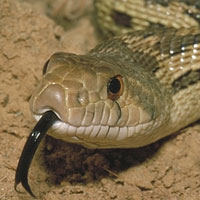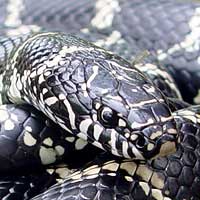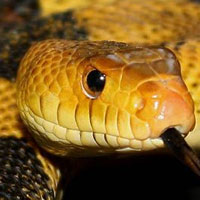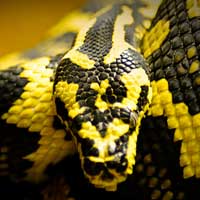All You Need to Know About Russell's Viper
The Russell's Viper (Daboia russelii) belongs to the Viperidae snake family, which includes highly venomous species equipped with long, hinged fangs for efficient venom delivery. Found across the Indian subcontinent, Sri Lanka, Southeast Asia, and southern China, this snake is characterized by its distinctive light brown body adorned with dark circular markings.
Scientific Name: Daboia russelii
Snake Family: Viperidae
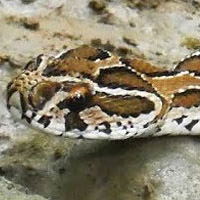
An Overview of Russell's Viper
Russell's Viper (Daboia russelii) is one of the most venomous snakes found in Asia, particularly in India, Sri Lanka, and Southeast Asia. This snake is known for its striking appearance, with a light brown body covered in dark circular markings, and its potent venom that poses significant medical risks. Russell's Viper is a key species in its ecosystem, helping to regulate populations of rodents and other small animals. Despite its venomous reputation, it is generally non-aggressive unless provoked, but caution is essential when in its proximity. It plays a crucial ecological role in controlling rodent populations while being recognized as one of the most medically significant snakes due to its potent venom and frequent encounters with humans in its extensive range.
Where Does Russell's Viper Live?
Russell's Viper is highly adaptable and inhabits a wide range of environments. Key habitat characteristics include:
- Geographic Range: Found across the Indian subcontinent, Sri Lanka, parts of Southeast Asia, and southern China.
- Preferred Environments: Grasslands, agricultural fields, scrublands, and forested regions.
- Climate: Thrives in tropical and subtropical climates with moderate to high humidity.
This snake is often found in areas close to human settlements due to the abundance of prey such as rodents. It seeks shelter under rocks, in burrows, or amidst dense vegetation to avoid predators and extreme weather. Below is a table summarizing its habitat preferences:
| Habitat Feature | Description |
|---|---|
| Geographic Range | Indian subcontinent, Southeast Asia, southern China |
| Preferred Terrain | Grasslands, agricultural fields, scrublands |
| Climate | Tropical and subtropical |
What Does Russell's Viper Eat?
Russell's Viper is a carnivorous predator with a diet that reflects its role as an ecosystem regulator. Key dietary details include:
- Primary Prey: Rodents such as rats and mice, which form the bulk of its diet.
- Occasional Prey: Frogs, lizards, and birds.
- Hunting Strategy: Ambush predator that relies on its camouflage to remain undetected before delivering a swift and venomous strike to immobilize prey.
By preying on rodents, Russell's Viper plays a critical role in controlling populations of agricultural pests. Its hunting efficiency and adaptability allow it to thrive in both natural and human-altered landscapes.
Understanding the Behavior of Russell's Viper
Russell's Viper exhibits several distinctive behavioral traits that contribute to its survival. Key behaviors include:
- Activity Patterns: Primarily nocturnal, although it may be active during cooler parts of the day.
- Defensive Behavior: When threatened, it coils its body and emits a loud hissing sound as a warning before striking.
- Social Behavior: Solitary, except during the mating season.
This snake is generally non-aggressive but can become defensive if provoked. Understanding its behavior is crucial for avoiding accidental encounters and ensuring safe coexistence.
Health and Lifespan of Russell's Viper
Russell's Viper is a resilient species with a relatively long lifespan. Important health considerations include:
- Lifespan: 10-15 years in the wild, with individuals in captivity often living longer under optimal care.
- Health Threats: Habitat destruction, human persecution, and road mortality are significant risks.
- Predators: Birds of prey, mongooses, and larger mammals pose threats, particularly to juveniles.
Efforts to conserve its natural habitat and educate the public about its ecological importance are vital for ensuring the survival of this species.
How Does Russell's Viper Reproduce?
Russell's Viper has a reproductive strategy that ensures the continuation of its species in various environments. Key details include:
- Mating Season: Occurs in the spring and early summer.
- Reproductive Method: Ovoviviparous, meaning females give birth to live young rather than laying eggs.
- Litter Size: Produces 20-40 offspring per litter, depending on the female’s size and health.
- Hatchling Behavior: Newborns are fully venomous and independent, capable of hunting small prey immediately.
The high reproductive rate of this species ensures its survival despite the challenges posed by habitat loss and predation.
Safety Guidelines for Handling Russell's Viper
Handling Russell's Viper requires expertise and strict safety measures. Essential safety tips include:
- Always use professional tools such as snake hooks and secure transport containers.
- Wear protective gloves and boots to minimize the risk of envenomation.
- Ensure enclosures replicate the snake’s natural habitat and are escape-proof.
- Keep antivenom readily available and have a detailed emergency protocol in place.
Only trained professionals should handle this species. Public awareness of its behavior and ecological role can help reduce fear and unnecessary harm to both humans and the snake.
Disclaimer
The information provided in this article is for educational purposes only. SnakeEstate strongly advises against handling or interacting with venomous snakes, such as Russell's Viper, unless you are a trained and licensed professional. These snakes pose significant risks, and improper handling can result in serious injury or death. Always adhere to local regulations and prioritize safety when dealing with wildlife.
Other Snakes In This Species
 Asp Viper
Asp Viper Black Mamba
Black Mamba Boomslang
Boomslang Brazilian Coral Snake
Brazilian Coral Snake Bushmaster
Bushmaster Coastal Taipan
Coastal Taipan Common Death Adder
Common Death Adder Common European Adder
Common European Adder Copperhead
Copperhead Coral Snake
Coral Snake Cottonmouth
Cottonmouth Eastern Brown Snake
Eastern Brown Snake Eastern Diamondback Rattlesnake
Eastern Diamondback Rattlesnake Egyptian Cobra
Egyptian Cobra Fer-de-lance
Fer-de-lance Forest Cobra
Forest Cobra Indian Cobra
Indian Cobra Inland Taipan
Inland Taipan Jameson’s Mamba
Jameson’s Mamba King Cobra
King Cobra Lancehead
Lancehead Lataste’s Viper
Lataste’s Viper Malayan Krait
Malayan Krait Mojave Rattlesnake
Mojave Rattlesnake New Guinea Small-eyed Snake
New Guinea Small-eyed Snake Nose-horned Viper
Nose-horned Viper Puff Adder
Puff Adder Russell’s Viper
Russell’s Viper Saw-scaled Viper
Saw-scaled Viper Solomon Island Coral Snake
Solomon Island Coral Snake South American Rattlesnake
South American Rattlesnake Tiger Snake
Tiger Snake Western Diamondback Rattlesnake
Western Diamondback Rattlesnake



